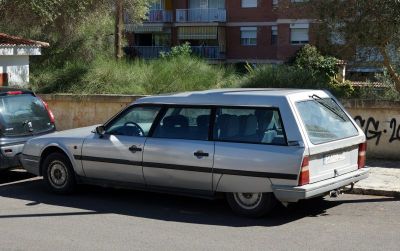 1960 Citroen ID I Break Dimensions, Size & Specs
1960 Citroen ID I Break Dimensions, Size & Specs
Measurements of the 1960 Citroen ID I Break, engineered for optimal performance and comfort
| Dimensions | |
|---|---|
| Length: | 4975 mm195.9 in16.3 ft |
| Width: | 1790 mm70.5 in5.9 ft |
| Height: | 1530 mm60.2 in5.0 ft |
| Weight Specifications | |
| Curb Weight: | 1320 kg2910 lbs |
| Maximal permitted Weight: | 2000 kg4409 lbs |
The Citroen ID I Break, produced from 1959 to 1963, is a distinctive classic station wagon known for its spacious dimensions and elegant design. Introduced in the 1960 model year, this generation of the ID series showcased Citroen's commitment to innovation in both aesthetics and practicality. Measuring 4975 mm (approximately 196 inches) in length, 1790 mm (about 70.5 inches) in width, and standing 1530 mm (roughly 60 inches) tall, the ID I Break offered a roomy interior conducive to family use and cargo transport. Weighing 1320 kg (about 2910 lbs) curb weight and accommodating a maximum weight of 2000 kg (approximately 4409 lbs), the vehicle balanced durability with efficient handling for its time. Its extended body allowed for increased storage space without compromising its sleek silhouette, making it ideal for those seeking a blend of utility and classic automotive style. As a station wagon, the Citroen ID I Break reflected the post-war European demand for versatile vehicles that could navigate urban and rural environments comfortably. This model remains a celebrated example among vintage car enthusiasts for its size attributes and the pioneering engineering typical of Citroen's mid-20th-century lineup.
Discover the standout features that make the 1960 Citroen ID I Break a leader in its class
Have a question? Please check our knowledgebase first.
The Citroën ID I Break measures 4975 mm (195.9 inches) in length, 1790 mm (70.5 inches) in width, and 1530 mm (60.2 inches) in height. These dimensions make it a relatively large station wagon for its time, providing ample interior space and cargo capacity. Its length and width contribute to a spacious feel inside the cabin, while the moderate height ensures it maintains a balanced and aerodynamic profile.
The curb weight of the Citroën ID I Break is approximately 1320 kg (2,910 pounds). This reflects the vehicle's weight when fully equipped with necessary operating consumables and a full tank of fuel, but without passengers or cargo. Its maximum weight capacity, or gross vehicle weight rating (GVWR), is 2000 kg (4,409 pounds), indicating it can safely carry additional load, passengers, and cargo up to this limit without compromising safety or performance.
Yes, the Citroën ID I Break can generally fit into a standard residential garage. With a length of 4975 mm (195.9 inches) and a width of 1790 mm (70.5 inches), it fits comfortably within the typical garage dimensions, which are often around 6 meters (20 feet) in length and 2.4 to 3 meters (8 to 10 feet) in width. The height of 1530 mm (60.2 inches) is also well below the average garage door height, ensuring easy entry and storage.
The Citroën ID I Break, produced between 1959 and 1963, carried forward the balanced proportions of the earlier Citroën ID models but with subtle refinements. While the ID I Break maintained a similar length to its predecessor sedans, its station wagon body style resulted in a more practical height and cargo space configuration. Compared to earlier ID sedans, the Break offered enhanced utility without significant increases in width or curb weight, striking a good balance between spaciousness and maneuverability.
The Citroën ID I Break's length of 4975 mm (195.9 inches) and width of 1790 mm (70.5 inches) made it competitive among station wagons of the early 1960s. Many contemporaries were similar in length but often wider due to American influences on station wagon design. The ID I Break's relatively modest width helped with European urban driving conditions while still providing spacious seating and cargo area, reflecting Citroën's focus on practicality coupled with streamlined dimensions.
The Citroën ID I Break stands 1530 mm (60.2 inches) tall, offering a good headroom for passengers and a comfortable driving position. Its ground clearance, while not specified explicitly but typically moderate for station wagons of that era, helps the vehicle manage rough rural roads and urban obstacles without difficulty. The height dimension guarantees visibility and ease of ingress and egress, while balancing aerodynamic efficiency for improved handling and fuel economy.
The interior space of the Citroën ID I Break benefits directly from its generous dimensions, especially the length of nearly 5 meters (16.3 feet). The station wagon design maximizes usable cargo and passenger room, with ample headroom due to its 1530 mm (60.2 inches) height. The width of 1790 mm (70.5 inches) allows for comfortable seating configurations. These factors provide a roomy cabin suitable for families or carrying larger loads, emphasizing practicality alongside passenger comfort.
While exact cargo volume figures are not typically detailed for the 1960 Citroën ID I Break, its station wagon body style and overall dimensions (length nearly 5 meters and generous width) mean it has significant cargo space, especially with rear seats folded or removed. The upper height profile and large rear hatch design enhance ease of loading bulky items. With a maximum weight capacity of 2000 kg (4,409 pounds), the Break can carry substantial payloads, making it highly practical for transporting goods and luggage.
The curb weight of the Citroën ID I Break is 1320 kg (2,910 pounds), which places it within a moderate range for station wagons of its era. The weight contributes to a stable ride quality and improved road grip, especially at cruising speeds. However, added weight can influence fuel consumption, making the car less efficient than lighter models. Citroën's advanced suspension and engineering help to mitigate these effects, offering a comfortable and reasonably efficient driving experience despite the vehicle's size and mass.
The Citroën ID I Break distinguishes itself from other early 1960s European station wagons through its combination of length, innovative design, and practicality. Compared to contemporaries like the Peugeot 404 wagon or Volkswagen Variant, the ID I Break offers a slightly longer overall length at 4975 mm (195.9 inches) and a unique suspension system tuned for comfort and stability. While some rivals might be slightly wider or have different engine layouts, the ID I Break stands out for its spacious cabin, reinforced utility, and innovative design philosophy addressing both style and function.
Discover similar sized cars.

| Production: | 1985-1991 |
|---|---|
| Model Year: | 1986 |
| Length: | 4929 mm194.1 in |
| Width: | 1770 mm69.7 in |
| Height: | 1475 mm58.1 in |

| Production: | 1966-1967 |
|---|---|
| Model Year: | 1962 |
| Length: | 4990 mm196.5 in |
| Width: | 1790 mm70.5 in |
| Height: | 1530 mm60.2 in |
